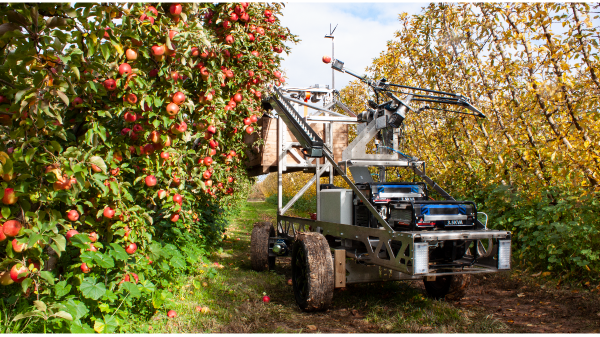It’s in the field that our experts see the most potential for game-changing developments in robotics, and they were all forthcoming about how the technology can improve production from alleviating the labor crunch to better-quality harvests and less product loss.
“We build and operate our own fruit-picking robots, using our own designs,” says Hunter Jay, CEO of Australia-based Ripe Robotics. “We can optimize for the things growers care about—speed, price, quality of the pick—without optimizing for things that off-the-shelf robots usually need, like millimeter-level precision.”
Ripe Robotics also runs the robots itself instead of selling them or requiring growers to operate them. This creates a much greater ease-of-use scenario, as growers can hire the company to pick the crops, just as they would human pickers, and Ripe Robotics can see firsthand what works and what doesn’t in the field, aiding with future upgrades.
“Our robots will change things for growers as we scale up, reducing the amount of labor they need to find and manage each year,” observes Jay, “and giving them much more information about what’s going on with their fruit throughout the season.”
Labor issues are also first and foremost in the mind of Gad Kober, vice president of business development for FFRobotics, based in Israel.
“Robotic harvesting of any fruit has a peculiar and important impact on growers—it significantly reduces dependence on the availability of human labor, which is becoming scarce,” Kober points out.
Robotics also reduce the all-inclusive costs of ongoing human labor, including wages, cost of living, transportation, and insurance, as well as introducing improvements in the quality of the produce picked.
“As a consequence, it increases the efficiency and productivity of fruit picking—more target fruits in the bin—all leading to increased profitability for the grower,” Kober concludes.
Richter of Muddy Machines goes into further detail about the specific functions and advantages robotics have over human labor. “We’re building a robotic tool carrier platform aimed at processes that are currently only possible by hand—selective harvesting, hand-weeding, and several others,” he explains.
These specific tools, he notes, can be interchangeable depending on where and why the robot is deployed. Capital-intensive components such as the drivetrain, motors, batteries, and processors can be reused for various purposes and crops throughout the growing season.
This allows the company to compete with the cost of manual labor from the beginning of the use cycle instead of having to recoup major investments from a single crop.
“Beyond making access to labor more scalable and plannable, we expect to be able to demonstrate yield improvements from mechanical labor,” says Florian Richter, founder and CEO of Muddy Machines, based in London, England.
Mark DeSantis is CEO of Pittsburgh, PA-based Bloomfield Robotics, a company that uses technology developed at the Robotics Institute at Carnegie Mellon University, ranked first in the world for development of automation.
According to DeSantis, a major advantage in building robotics for harvesting fruits and vegetables is being able to control every aspect of production, an approach he equates to the paradigm shift in automotive manufacturing pioneered by Japanese builders in the 1960s. It’s an approach that means much more than simple labor cost savings.
“If you equate, say, an apple orchard as a ‘food factory,’ the process starts in the winter and finishes in the spring,” he notes. “If I know to a granular level everything I’m doing to that tree, and I know the productivity of that tree—not the orchard or acre, but that tree—then I can orient my treatment of that tree around its capabilities.
“The analogy I use is the difference between tutoring and sitting in a classroom,” DeSantis continues. “If I can do that, then I can dramatically improve the productivity of the farm without necessarily adding more water, more fertilizer, more nutrients. I now know the impact I’m having on that particular plant throughout its life.”
It is this function of the AI and sensors, the “brains” of the robots rather than their mechanical “limbs,” that provides the greatest advantage to Bloomfield’s robots.
This is an excerpt from the Applied Technology department in the March/April 2023 issue of Produce Blueprints Magazine. Click here to read the whole issue.



